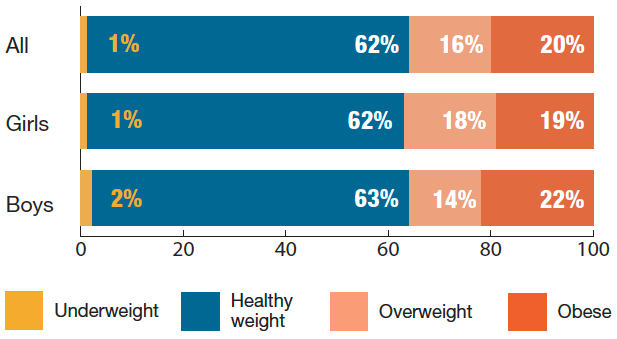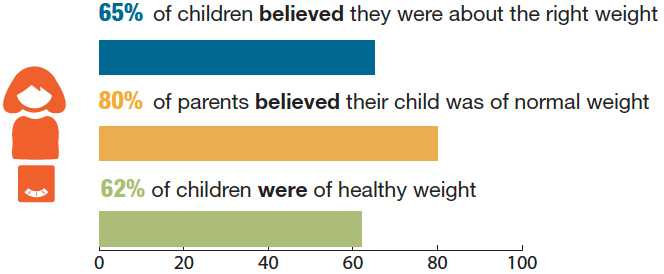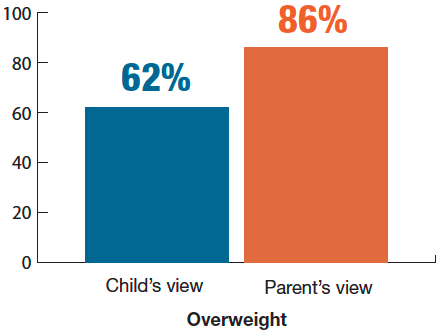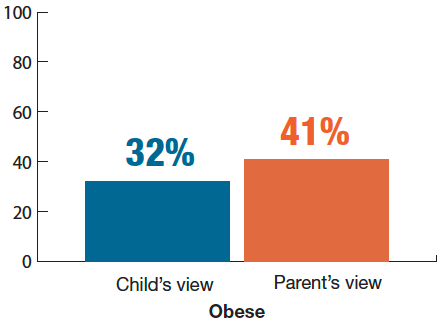Growing up in Scotland: life at age 12
Some initial findings about the lives of 12-year-old children living in Scotland, using data collected from the Growing Up in Scotland study (GUS).
Healthy weight and perception of body weight
In GUS, children’s height and weight are measured by interviewers as part of the household visit. This information is used to calculate body mass index. The classification of children’s body mass index (BMI) used here has been derived from BMI percentiles of the UK 1990 reference curves referred to as the national BMI percentiles classification. These thresholds are widely used to describe childhood overweight and obesity prevalence trends in the UK – including in previous analysis of GUS data - as follows[5]:
- At or below 2nd percentile: at risk of underweight
- Above 2nd percentile and below 85th percentile: healthy weight
- At or above 85th percentile and below 95th percentile: at risk of overweight
- At or above 95th percentile: at risk of obesity
Sixty-two percent of children were healthy weight whilst 36% were overweight including 20% who were obese. Only a very small proportion of children (1%) were underweight. There was no statistically significant difference between boys and girls in any of the categories.
Children’s BMI classifications

To measure perceptions of weight, children were asked whether they thought their body was much too thin, a bit too thin, about the right size, a bit too fat or much too fat. Similarly, parents were asked how they would describe their child’s weight from four categories: underweight, normal weight, somewhat overweight or very overweight. Around two-thirds (65%) of the children considered themselves to be about the right size. Similarly, a large majority of parents (80%) believed their child to be of normal weight.
Perceptions of children’s weight and actual weight

There were few notable differences in children’s and parental views on weight based on the child’s gender. Boys were more likely than girls to consider themselves a bit too thin (11% compared with 4%). Similarly, parents of boys were more likely than parents of girls to consider their child underweight (7% compared with 3%) despite there being no significant difference in the percentage of boys and girls who were underweight.
Whilst parents were more likely than children to recognise healthy/normal weight, they were less likely to recognise overweight/obesity. When comparing parent and child perceptions of weight and body size to BMI measurements, 78% of healthy weight children believed themselves to be about the right size and 92% of their parents described their child’s weight as normal. This means a significant minority (22%) of healthy weight children do not recognise their weight as being about right. Around half of these children (11%) believed they were a bit too thin and a similar proportion (10%) thought they were a bit too fat.
62% of children who were overweight perceived themselves to be about the right size and 86% of parents whose children were overweight perceived their child’s weight as normal

The discrepancy between actual and perceived weight increased significantly amongst children who were overweight (not obese) - 62% thought they were about the right size and 86% of their parents thought their child’s weight was normal. Similarly, amongst children who were obese, 32% believed they were about the right size and 41% of parents thought their child’s weight was normal.
32% of children who were obese perceived themselves to be about the right size and 41% of parents whose children were obese perceived their child’s weight as normal

Contact
Email: GUS@gov.scot
There is a problem
Thanks for your feedback